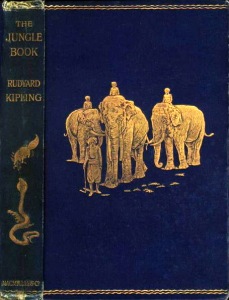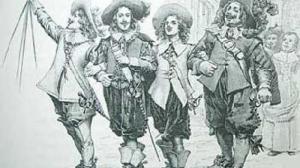“All for one, and one for all!” — the Three (and sometimes Four) Musketeers
Time to finish the “2024” edition of the “Notable Genre Anniversaries”. I think you will agree that these two properties are indeed classics with long-lasting legacies, and thus deserve to be celebrated as such. Enjoy!
The Jungle Book (1893/94): 130 years
While in his late-20s, young Rudyard Kipling — an English novelist, short-story writer, poet, and journalist — first began publishing his series of short stories featuring anthropomorphic jungle creatures like ‘Bagheera’ (the black panther), ‘Kaa’ (a 30-foot python), ‘Baloo’ (a bear), and of course ‘Mowgli’ (the abandoned “man-cub” raised by wolves). Though living in Vermont (U.S.A.) at the time, the stories were set in British India, where Kipling had spent several years of his childhood. Most of the character names were simply transliterated Hindustani names for the types of animal they were. (For example, “baloo” means “bear”.) The collected stories were published as The Jungle Book (1894), the success of which spawned a sequel, The Second Jungle Book, the following year.
The Jungle Book tales are fables, meant to teach moral lessons. Certain connections can be seen with ancient Indian fable texts such as the Panchatantra. Kipling admitted that “it is extremely possible that I have helped myself promiscuously but at present cannot remember from whose stories I have stolen”. Central themes of the stories include abandonment & fostering (e.g., Mowgli’s loss of his parents at the beginning of his story, then being adopted by the wolf pack) and law & freedom (e.g., Kipling’s “law of the jungle”, which “required obedience and ‘knowing your place’, but also provided social relationships and ‘freedom to move between different worlds'”).
Some critics over the years have complained about imperialist and/or racist attitudes of the time shining through (e.g., Jopi Nyman) or a certain didactic aspect to the imparting of lessons/wisdom (e.g., Kingsley Amis). But, even from the beginning the reviews have been generally positive.
“[O]ur sincere thanks to Mr Kipling for the hours of pure and unadulterated enjoyment which he has given us, and many another reader, by this inimitable ‘Jungle Book’.” — The Athenaeum (16 June 1894)
Swati Singh has noted that even critics wary of Kipling for his supposed imperialism have admired the power of his storytelling.
At the request of Robert Baden-Powell, founder of the Scouting movement, Kipling allowed use of the Jungle Book’s “universe” as motivational material for the Cub Scouts. The Jungle Book has appeared in over 500 print editions, over 100 audiobooks, and has been translated into at least 36 languages. Adaptations to varying degrees have been done as novels and related books, musical compositions, radio broadcasts, comic books and manga, cartoons, films, and stage productions. There has been a variety of miscellaneous merchandise over the years, as well.
The Three Musketeers (1844): 180 years
Les Trois Mousquetaires was written 180 years ago by French author/playwright Alexandre Dumas and his ghostwriter collaborator, Auguste Maquet. The two worked on other stories together, as well. Maquet did the bulk of the historical research and came up with possible plot outlines for Dumas to consider. After choosing, Dumas then fleshed out the story, adding and removing characters as needed, and giving it all his personal flair.
The “musketeers” story was essentially an historically-based adventure of the swashbuckler genre. But, given its setting (1625-1628) in Louis XIII’s reign during France’s Ancien Régime, it also served up some political commentary. The story was first serialized in the newspaper Le Siècle from March to July 1844, during the July Monarchy, four years before the French Revolution of 1848 established the Second Republic. The character of young D’Artagnan, who joined the titular trio, is based on the real-life figure of Charles de Batz-Castelmore d’Artagnan, who went on to serve King Louis XIV and eventually became captain of the Musketeers of the Guard.
The Three Musketeers was a rather long novel (~700 pages), and it is sometimes split into one section focusing on the introduction of D’Artagnan, followed by the second section focusing on Milady de Winter’s machinations and mission. A sequel, Twenty Years After, was serialized from January to August 1845 and took place between 1648 and 1649. A second sequel, The Vicomte of Bragelonne: Ten Years Later, was serialized from October 1847 to January 1850 and set between 1660 and 1673. (This third book is often split into three novels, each roughly the length of The Three Musketeers. One of them is The Man in the Iron Mask.) The three books are known collectively as The d’Artagnan Romances. A fourth sequel, The Red Sphinx, was never completed, though it is said that Dumas’ novella, The Dove, takes care of that. That said, none of the original characters return for The Red Sphinx, with the focus being on a new hero, the Count of Moret (based on the real-life Antoine de Moret).
There were three English translations of The Three Musketeers in the 1800s, as well as translations into other languages. There have been three modern English translations since then. There have been several film adaptations, as well as both live-action and animated TV versions. (There was even a series adapted for Korean history which aired in 2014.) Both musical and non-musical theatrical productions have been made; same goes for audio productions. There have been video games, board games, a web series, novels (including unofficial sequels), comic books. Aside from outright adaptations (even very loose ones), the Musketeers have also inspired and/or been referenced in other books, games, manga, music, TV & film.
On a personal note, I recently re-watched the 1993 film starring Kiefer Sutherland, Chris O’Donnell, Rebecca De Mornay, Tim Curry, et al., and I quite enjoyed it. I’m looking forward to re-watching the duology made back in the mid-1970s, starring Richard Chamberlain, Michael York, Faye Dunaway, Christopher Lee, etc., which I remember quite fondly. Eventually, I’ll probably re-watch the 1948 adaptation as well, which starred Gene Kelly, Van Heflin, Lana Turner, Vincent Price, and others.
That about wraps up our notable genre anniversaries for 2024, as well as the larger series as a whole. I hope somebody read and enjoyed them besides me. Feel free to re-read each set at the appropriate 5-year intervals… 🙂







